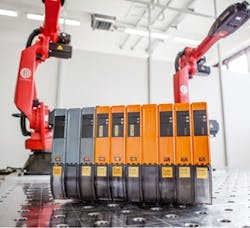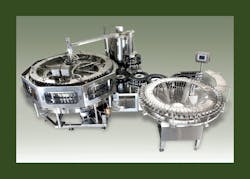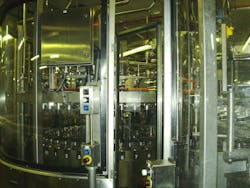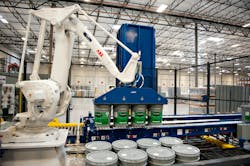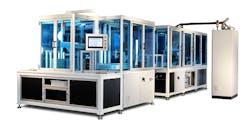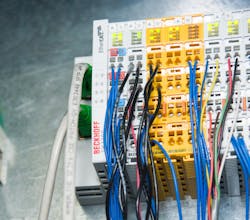Technology makes machines safer
For sheet metal fabricator Marlin Steel, spending money on safety technology makes dollars and sense. President Drew Greenblatt says the Baltimore, Maryland-based company invests millions in automation because it increases productivity, cuts cycle time and improves quality. It also makes manufacturing better in other ways.
“We’re able to ship product that’s made in a safer fashion because our employees are less likely to get hurt,” Greenblatt says. “We’ve gone more than 2,295 days without a safety incident. We attribute a lot of that to the technology and the robots.”
A non-automated company of a similar size would typically have had 18 to 30 injuries over that same span, according to Greenblatt. Thanks to its safety record, Marlin Steel saves money in insurance premiums and is better able to retain skilled employees, who value a company that demonstrates it values them.
But, at the same time, there are aspects of safety technology that Greenblatt would like to see improved. Chief among these are alerts that warn of attempts to defeat or bypass safety systems. Another desired innovation involves better sensors and systems, largely as a means to allow humans and robots to work more closely together.
Safety in numbers
As Greenblatt demonstrates, there’s a demand for safety technology, particularly if it’s part of an overall automation and productivity package. However, there also is room for improvement.
Figure 1: This bottle filler is made safer with safety guards, convenience lights for diagnostics, locking switches and clear radial guarding for full visibility.
Source: Bevcorp
Sales of safety sensors and switches will reach $3.3 billion yearly worldwide by 2020, according to a new report from analyst firm IndustryARC. The heavy machinery used in manufacturing has the potential to crush, amputate, burn or blind, causing severe workplace injuries. That makes the use of sensors a necessity to protect workers, and it explains the 3.1% compound annual growth rate in sales, says Industry Consultant Ravi Medichelmela.
Willoughby, Ohio-based Bevcorp is one reason for the growth in safety-related technology. That is due to a philosophy followed by the maker of rotary fillers, blending equipment and handling parts for the beverage industry (Figure 1).
“We design for safety-standard compliance, but we go above that by adding features and functionality and using the latest technologies, which gives the flexibility to maximize uptime,” says Eric Hendrickson, engineering manager for electrical and mechanical.
On the technology front, the company makes use of Ethernet-based safety PLCs and similar controls, finding this improves diagnostics and adds flexibility. Because of the technology, something like a door, for example, can be added without having to run so many wires. That gives the OEM the capability to better adapt a machine to a specific customer or situation.
Figure 2: Bevcorp makes use of Ethernet-based safety PLCs and similar controls, finding this improves diagnostics and adds flexibility.
Source: Bevcorp
As for other design changes technology now enables, Hendrickson cites what was done with a bowl used in the filling process. The product within it has to be maintained at a certain level, with more periodically added in a foam-free fashion. Previously, a product change or adjustment required stopping a machine, opening up guarding, making a mechanical adjustment, closing up the machine and starting it up again—a time-consuming sequence that might have to be repeated. Now, an electronic level control system that sits inside the guarding and communicates wirelessly enables adjustments to be made without stopping the machine at all.
Bevcorp uses products from Rockwell Automation, and Hendrickson says these offerings have evolved over time. That allows OEMs to offer more diagnostics and options. Looking forward, Hendrickson notes that safety technology vendors are trying to make devices that cannot be circumvented through the addition of redundancy and double-checking of conditions, all to better spot attempts at altering or bypassing safeguards (Figure 2).
Figure 3: Machine safety equipment makes this robotic palletizing cell handling heavy paint drums safe and running at peak efficiency.
Source: ABB Jokab Safety
Matthew Miller, a machine safety specialist at ABB Jokab Safety Products, notes that making a true calculation about the cost and payback of safety should account for everything, and that leads to one conclusion (Figure 3). “The rewards easily outweigh the investment,” says Miller. “An unsafe machine can result in injured employees, production downtime, paying workers’ compensation, lawsuits and fines and increased insurance premiums, just to name a few.”
Safety after the fact
Innovations are changing how safety technology is implemented. Take the case of MGS Automation, a Germantown, Wisconsin-based provider of custom automation systems. As part of an upgrade, MGS opted to go with distributed safety I/O, choosing to do so as a way to save money while meeting safety requirements (Figure 4).
“Since this particular machine consisted of many independent modules and sections, each with unique safety requirements, we wanted to localize hardware on each module and minimize the wiring required back to the main control cabinet,” says Craig Nisleit, electrical engineer at MGS.
Figure 4: With a distributed safety solution, MGS Automation could distribute I/O across various locations on the machine while maintaining a single point of control.
Source: Phoenix Contact
To do this, MGS used products from Phoenix Contact USA to create a distributed logic module with communication handled by a special protocol running over an already-installed standard network. Called a black or grey channel, this approach yields safe communication over a standard automation protocol, says Zachary Stank, a safety product marketing specialist at Phoenix Contact.
This method allows an upgrade and improved safety to be added to an existing machine without demanding a complete redesign. However, it does require care be taken.
“It’s just like adding I/O to a system,” Stank says. “The more I/O you add to a PLC, it affects how quickly that PLC can respond.”
That response time plays a role in keeping a machine running safely. For all safety systems, there are watchdog timers in place to make sure that I/O is functioning correctly and communicating as required. If the timer is too short, then the watchdog will trip and cause a machine to go down, perhaps unnecessarily. However, if a watchdog timer has the opposite problem, then it may take too long to bring a machine to a safe stop.
MORE: Machine Safety Fits Everywhere
Setting a watchdog timer up so that it’s in the sweet spot with regard to duration requires knowing how long a safety control system takes to react. The other bit of information that’s needed is the nature of the dangers the machine presents.
Finding that out requires a risk assessment, something that should be done for all automated machines and use scenarios. Chris Gerges, CEO of safety assessment and integration firm Safe-T-Sense of Schaumburg, Illinois, notes that the list of job functions to consider includes operators, maintenance, engineering, management and EHS. Part of the consideration must also be that in some cases people may try to defeat safeguards, so the system must take this into account and protect against it.
In the United States, the ISO 13849 standard is having an impact, according to Gerges. Large users are requiring machine builders to comply with this. Unfortunately, the probabilistic approach the standard takes to safety can make following it challenging for smaller machine builders. There are several aspects to take into account when determining the safety performance level that the standard calls for, including the circuit category structure, mean time to dangerous failure, diagnostic coverage, common cause failures and systematic faults. These all play a role in the calculations.
The best solution for reducing risk is to design out the hazard. If that cannot be done, then “it’s really going to require proper engineering to make sure that the device is wired properly in a safety control circuit and actually stops motion in a reliable manner,” says Gerges.
Safety combo
Still, other advances enable an integrated platform for motion control, other control functions and safety, which can lead to significant savings. Avon, Massachusetts-based i-Web has put this capability to work in its systems for the processing and finishing of commercial print and packaging products.
Figure 5: Using an integrated control and functional safety system, i-Web implements a wide range of e-stops, safe stop functions, guard interlocks and other safety equipment.
Source: Beckhoff Automation
These systems consist of machines that fold, cut, perforate, glue and stack printed items, but the exact configuration varies by customer and application. One commonality is the need to control a large number of motion axes, which requires quite a bit of data throughput (Figure 5). Depending upon the printing process, there may be a need to precisely synchronize multiple direct-driven rollers.
On the safety front, i-Web implements emergency stop, interlock and other safety-related systems. Since modules can be added to or removed from each printing line, every module must have its own safety system.
Thanks to a fast-enough fieldbus and sufficiently capable safety and control components, i-Web was able to integrate control and functional safety. By doing so, the company avoided implementing a separate safety network and was able to achieve some significant savings, says President Bob Williams. “Required electrical cabinet space has dropped by 50%,” he says. “In terms of the automation and controls equipment, there has been an impressive 75% reduction in time required for electrical installation in the field.”
For its integrated approach, i-Web chose a PC- and EtherCAT-based control platform from Beckhoff Automation. This was done, in part, because this technology enabled communication with up to 100 servo motor axes in 100 µs, Williams says. This resolved the bottleneck created by the fieldbus previously used. It also increased safety, since it takes less time to react to dangerous conditions and initiate a stop sequence.
Kurt Wadowick, Beckhoff I/O and safety specialist, notes that safety was originally a hardware solution. When a fault occurred in any moderately complex system, it took time to study a circuit schematic, trace wiring and signals and measure voltages in order to finally figure out what had happened and then correct it.
Now safety can increasingly be implemented in software. That makes it is easier to integrate with other control functions. Less wiring is needed, and cost is reduced. Also, troubleshooting is much easier and faster. “Now, in our function blocks, we’re giving you all the diagnostics of every function block, bringing it up to the HMI screen,” Wadowick says.
He adds that in an integrated setup the safety controller runs on a separate processor from the PLC. This means that changes can be made to the control software without impacting safety operations. Working with the two systems is made easier because the PLC code, hardware configuration, motion control and safety run under one software platform.
That demands a degree of awareness of the differences between how the control system treats certain items and how something seemingly very similar is handled in the safety environment, Wadowick cautions. For instance, the output associated with a timer-off function in a PLC will stay on until a specific time has elapsed, no matter what. In a safety system, a timer-off function will immediately go to a Volt-free, Watt-less state if a fault occurs. The difference in behavior arises because in functional safety everything must be in a known state at all times, and that leads to this kind of difference in behavior. Controls engineers must get used to such differences when working with an integrated functional safety system, according to Wadowick.
Free robots
Robots often are currently walled off for safety reasons, with perimeter guards and other technology protecting people from harm. An example can be seen in a project undertaken by Schmersal USA. The company has a customer that builds assembly equipment with automated tooling, robots and conveyors, says Mike DeRosier, engineering services manager.
He says this OEM wanted to improve the overall design of a machine while increasing productivity and maintaining current safety levels. To pull this off, a perimeter guard was added with both sliding and swing type doors for operator access. In this case, the first line of defense was not to allow an operator to reset the machine and put the robot into a running condition without everything being in line of sight due to a door remaining open.
The addition of various components and changes in guarding solved this problem. But, often stating the safety need is much easier than designing and implementing a guarding-based solution, DeRosier says. Instead, a better outcome can arise if what a machine needs to do, how it operates and functions and how it interfaces with safety is looked at in totality.
“It may be a combination of a guarding solution along with a change in function or process may also improve productivity, all with increased machine safety capabilities,” DeRosier says.
Figure 6: Enabling safe intermingling of people and robots will require technology other than guarding, such as setting allowable speed, reach and orientation for each degree of freedom.
Source: B&R Automation
That sort of thinking beyond guarding may be critical to getting robots to work freely and safely alongside people. Stephan Stricker, a solutions architect with B&R Industrial Automation Group, says that implementing this highly desired capability will involve making changes in a robot’s behavior. Instead of building a big enough cage, a robot could be made safe by setting a safety limited speed for every degree of motion, a safety limited position for every movement and a safe orientation, as a robot may have a mounted tool or laser that creates a hazard at an orientation-dependent distance (Figure 6).
Another key part of the solution is how to handle the situation when a machine is turned off. Stricker points out that the standard practice of moving a robot to a safe home position is difficult to do when machines and people freely intermingle. What’s more, the process of homing and then resuming operations adds time to a restart. A better answer is the use of a safety-rated encoder with some special capabilities.
“That allows you to turn off power but the encoder can still keep position,” Stricker says. “So, when you turn it back on, the encoder knows exactly where it is. The idea is you turn the machine off and turn it back on and you can pretty much start right away.”
When asked about other important trends and added capabilities, he says these include faster safety response times and deeper integration of safety. An example of the former being modules with response times measured in microseconds, instead of the typical milliseconds. This can be achieved by distributing simple safety and other functions to modules on the machine. As for deeper integration, the use of software instead of hardware makes this easier.
Heading toward nothing
New and improved technology has made implementing safety easier and promises to add important new capabilities. However, some things have not changed, nor are they likely to. For instance, meeting the appropriate safety standards is a big concern among machine users, according to Chris Marti, vice president of research, technology, safety and executive education at the Metals Service Center Institute (MSCI). The Rolling Meadows, Illinois-based nonprofit association serves the metals industry. It conducts an annual survey that tallies the rate of safety incidents and catalogs safety concerns.
“The metals industry has significantly better performance now, as opposed to a decade ago,” Marti says.
This data covers companies large and small, with the results somewhat fuzzy because the government definition of a recordable incident has evolved and expanded over the years. What have remained constant are the three main concerns that companies bring up in surveys. These are training, creating a safety culture and ensuring compliance.
David Sheer is vice president and general manager at Steel Supply, also in Rolling Meadows, Illinois. The value-added steel distributor has seen a drop in both incidents and near misses. Part of the improvement in safety has been the use of better technology, such as gloves and other personal protective equipment that can better ensure fingers and other body parts suffer no harm. In addition, other technology improvements include saws with blades that freeze on contact with any unintended object, as well as better door safety devices and switches.
That technology has to be accompanied by training and the creation of a safety culture. That requires constant vigilance to make sure safeguards are in use, which, in turn, demands a commitment that the company’s management fulfills.
“I walk out on the plant a couple times a day and watch things,” Sheer says.
Discussing the trajectory of machine safety, Bevcorp’s Hendrickson notes that years ago there was little or no safety and so machine uptime was at a maximum, something that end users value. Then the adoption of standards and the implementation of safety protocols caused uptime to take a hit. Now, technology advances have made it possible to be both safer and more productive by providing, for example, better diagnostics. In turn, that has caused a reevaluation among end users of safety.
“There’s more user acceptance,” Hendrickson explains.
Marti points to an industry goal of reducing the number of incidents to zero. The reasons for doing this are more than just monetary. “Safety is an ethical and moral responsibility,” he says. “You want everybody in your company to go home to their family at night, and you want them to go home in the same healthy condition they came to work in the morning.”
Marlin Steel is looking for equipment that keeps employees’ hands and fingers away from anything that will put them in harm’s way, says Greenblatt. “So, for example, we want guarding, lights, lasers, things of that nature to barricade our employees away from unsafe elements of the operation,” he says, echoing the desire to have everyone go home in one piece.
Sheer points out that anyone waging war against a 4,000-lb bundle of steel will always lose. Hence, there is a need for technology, training and the creation of a safety culture. “It doesn’t have to be 4,000 lb. It can be 50 lb. You’re still going to break something,” says Sheer. Improving safety and driving toward zero incidents can be good for any manufacturer because danger doesn’t only come from big machines and large chunks of metal.
